Laputa: Castle in the Sky
Take a ride through Jules Verne-inspired skies in this amazing Japanese adventure story for all ages.
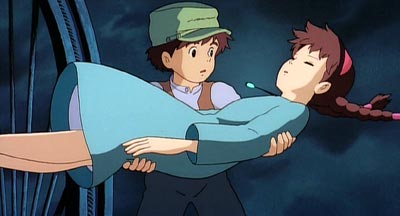
Japan; a land of madness whose cutting edge advancements in techno-wizardry disguise a history steeped in myth and discipline. Wales; cheese on toast, hills and slate mines. About as polar as two opposites can be, and I know which one I'd rather be living in. Ask yourself this; how many Welsh characters are there in the Street Fighter video games, eh? Exactly. Odd then that the mining communities of Wales should have provided legendary Japanese anime visionary and director Hayao Miyazaki with some of the inspiration for Laputa: Castle in the Sky, or Tenku no shiro Rapyuta as it is known on it's own turf.
Whilst visiting a mine-cum-museum in the land of Dai, Miyazaki was apparently struck by the passion of the miner's strike and the fervour with which the men were fighting for their jobs and communities. He was also taken by the stark imagery of the abandoned pit machinery, and it was these elements, combined with a Jules Verne-like vision of Northern Europe in the 19th century that gave birth to one of his best-loved (and certainly this reviewer's favourite) films.
Beginning onboard a magnificent airship, the film introduces us to a quiet little girl called Sheeta. She has, it transpires, been kidnapped by the military and whisked away from her home in the Northern town of Gondoa to aid them in their quest to find the mythical Laputa; a floating island of immense power and beauty constructed by an ancient civilisation many centuries ago. As one of the few remaining descendant's of Laputa's ruling family, Sheeta is in possession of a sacred Levistone; a crystal with levitational properties, the technology of which her ancestors built their culture on.
It is this stone that saves her when, in a bid to escape a boarding raid by a group of sky pirates, she climbs outside her window and slips, plummeting toward the ground. Rendered unconscious through fear, Sheeta is unaware that the magical pendant she is wearing has become active, slowing her descent and bathing the sky in a bright blue light. It is this light that attracts Pazu, a young boy who works the lift at the mine in his home village. Returning to the shaft with food for his boss, he sees Sheeta descending toward the pit and rushes to collect her.
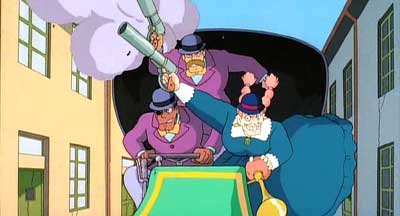
Pazu finishes his shift and carries the unconscious Sheeta home, making her comfortable for the night. In the morning Sheeta is woken by the sound of Pazu's trumpet with which he heralds the break of dawn to the village. Curious as to how her young saviour came to be living on his own, Sheeta discovers Pazu's father was a great adventurer and aviator who died in his search for Laputa. His death was not without some success, however, as Pazu shows his new friend a partially obscured photograph of the island his father claimed to have taken whilst airborne during a particularly brutal storm.
Heading down to the village to meet Pazu's boss, the young pair are accosted by the very same sky pirates who boarded the airship from which Sheeta fell. A motley crew indeed, the pirates are all brothers working with their parents Pa and Dola, who leads them in their treacherous ways. It transpires they too are after the Levistone, it's mystical powers able to light the way to Laputa where they hope to pillage from the floating island's untold riches. Narrowly avoiding capture, the pair flee on an elevated railway line where we first get a sense of Miyazaki's team's grand scenery design. The line twists it's way through a wide chasm, into the walls of which are built residences and workhouses, the rails disappearing in and out of a network of intertwining caves. It superbly showcases the breathtaking imagination for which Studio Ghibli and Miyazaki in particular are famous, and gives us an early idea of the scale on which the film will be working.
The chase culminates in the pirates catching up with the children, only to be greeted by the military in an extremely imposing behemoth of an armoured train. As a rather one-sided battle erupts between their pursuers, the children fall from the rails, the power of the Levistone again saving them and setting them gently down in a cave network far, far below. Here they meet Pazu's old Uncle Pom, who explains to them the true power of the Levistone and the danger they will face in seeking the floating island. It is here that Sheeta also confides in Pazu that her mother passed on to her a number of old spells used by the Laputans, one of which activates the stone in times of danger, and another that has the potential to bring great destruction. Warned never to use the latter, Sheeta explains that to give power to the 'good' spells it was necessary also to know the dangerous ones. This is the first time in the movie that we begin to sense Sheeta's fear of the responsibility she unavoidably has to carry in being the guardian of the stone, and it helps to generate great empathy with the audience.
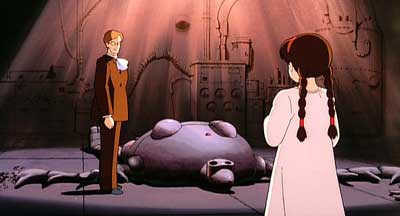
Unfortunately the military, guided by the mysterious and decidedly shady Muska, soon catch up with the duo and take them into captivity. Muska takes Sheeta to see the partially broken remains of a strange, rock-like robot said to have fallen to Earth one day, apparently from Laputa. Meanwhile he orders Pazu to head home, the young boy distressed at no longer being able to protect his friend. On returning to the village he decides to seek the help of the sky pirates, reasoning they are the only other people able to help him rescue Sheeta.
After much persuasion, Pazu manages to get Dola to agree to take him along as they make a daring raid on the military fortress where Sheeta is being held. In the interim, Muska has forced Sheeta into activating the stone with her mother's spell, and he is awestruck to see the stone in operation. He's even more amazed when the shattered robot is reanimated by the pendant, breaking free from it's confines and wreaking destructive mayhem within the compound. Initially fearful of the machine, Sheeta soon realises it is programmed to protect her, the bearer of the stone, and to this end it carries her to the roof of the tower where they are imprisoned in order for her to escape. With the military frantic to stop the robot, Sheeta is in danger of being killed in the ensuing shelling, but Pazu and the pirates reach her just in time in their 'flaptors' (a flying machine like a winged chariot; another superb mechanical design). Unfortunately Sheeta has lost the stone, and it is now in the hands of Muska who utilises it's way-finding beam to guide the giant army airship Goliath toward Laputa.
The pirates race off in pursuit with the young friends in tow helping with cooking and mechanical duties onboard their transport. Spotting Goliath, the pirates follow close behind with Sheeta and Pazu on watch duties in a glider attached by cable to the ship. A minor fracas ensues between the massive Goliath and the fragile but nimble pirate ship, and in the confusion Sheeta and Pazu become detached, ultimately coming to land on Laputa minutes ahead of their aggressors.
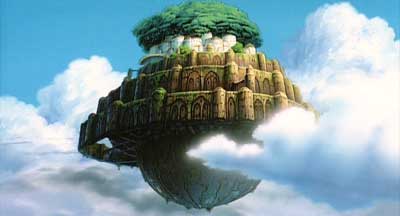
As the film reaches it's climax, the military invade the island but are double-crossed by Muska who turns out to be another of Laputa's descendants. Eager to command the destructive power of the island, he captures Sheeta and uses the stone to make his way to the island's core, from which he can control Laputa's immensely destructive armaments. I shan't spoil any outcome, but it's not hard to guess the general direction of the final?.
It's hard not to watch Laputa with a sense of awe; the sheer scale and imagination of character, animation, location design and plotting is second to none. One of the earlier 'major' movies outputted by Studio Ghibli, Laputa still has an air of freshness and unrivalled competence even in the new age of CG-enhanced anime. Individually, any of the elements that constitute the film are a marvellous achievement, but arguably Miyazaki's biggest accomplishment is in tethering them together to form a cohesive whole that although majestic, never threatens to overwhelm the viewer.
Although he claims not to write his movies with a view to establishing a moral standpoint, the director concedes that through natural due process they often end up embodying some aspect of his belief. here, the central theme is of man's abuse of technology he cannot even understand towards it's own, often nefarious ends. There's nothing new about that, even way back in 1986, but Laputa makes it's point in a gentle way without ever condescending or cack-handedly signposting it's message, unlike the vast majority of, for argument's sake, Disney movies. Treating it's audience with intelligence and respect, the film allows you to sit back and enjoy what is foremost a beautifully crafted and relayed adventure story. That any theme or moral settles in subconsciously while you're at it is merely a secondary consideration.
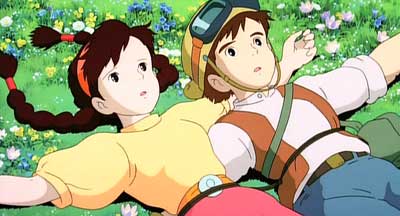
There is a general opinion that Laputa is one of the more complicated, meandering films of the Ghibli catalogue, the simple yet obvious point of the movie apparently lost on most journalists. As Helen McCarth says in her book Hayao Miyazaki: Master of Japanese Animation "If this level of detail and involvement is long-winded and complex, I'd like to make a plea for more long-winded and complex films and more directors strong-willed and gifted enough to make them". A standpoint I share completely. Much of the film's beauty lies in the complexity of story and setting, both entertaining and stimulating an audience's imagination, and it can hardly be argued that the film is not streamlined sufficiently; show me a character who is superfluous to the plot and I'll pull out my teeth with a pair of rusty pliers.
Instead, Laputa is a story that needs time to unfold properly, and Miyazaki is not a man to be rushed. If you can't handle an animated feature longer than 2 hours then it's your own loss, and a considerable one at that. It's a sheer work of imaginative genius, taking it's cue from Gulliver's Travels and running at a tangent with the ball across a spectacularly rendered playing field populated by the most exceptionally realised characters and locations you'll find.
I've had a fascination with this film from the time I first saw it during it's only UK television airing when I was a child. For years I searched for a copy in vain, desperately bothering anyone who'd listen about a magical animated feature film for imaginations young and old the likes of which you've never seen. Over a decade later the DVD revolution has meant no less than 2 shiny copies adorn my shelf, and boy do they have pride of place. Unsurprisingly given their own faltering business (ironically to the increasing popularity of imported Eastern features), Disney acquired distribution rights to Ghibli films in the US and Europe, and are hastily re-dubbing them with popular US actors in the voice roles. Princess Mononoke and Laputa are amongst the first to meet this fate, but for once I'd recommend you bow down to Mousedom and open your mind to what Western animation fans have been missing out on for decades; intelligent, beautifully crafted works of art for young and old alike. The Lion King? Don't make me laugh, Mickey.
Disko has awarded this movie 5 out of 5 Disko Flaptor Units.
Keiko Yokozawa (Sheeta)
Kotoe Hatsui (Dola)
Minori Terada (Muska)